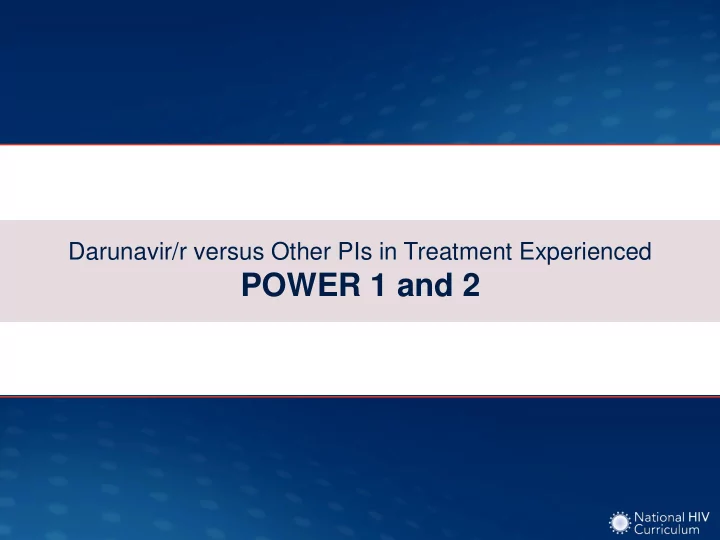

Darunavir/r versus Other PIs in Treatment Experienced POWER 1 and 2
Darunavir/r versus other PIs in Treatment-Experienced POWER 1 and 2: Study Design Study Design: POWER 1 and 2 • Background : Two randomized, phase 2b trials to compare the efficacy and safety of ritonavir-boosted Darunavir BID + RTV BID darunavir with other protease inhibitors in treatment- + OBR experienced HIV-infected patients with PI resistance (n = 131) • Inclusion Criteria (n = 155) - Age ≥18 - HIV RNA >1000 copies/mL - On PI-containing regimen - History of taking >1 NRTI, and ≥1 NNRTI as Control PI + RTV + OBR part of failing regimen (n =124) - At least 1 primary PI mutation at screening • Treatment Arms - Darunavir 600 mg BID + Ritonavir 100 mg bid + OBR* - Investigator-selected control PI + OBR* *OBR = Optimized background regimen: ≥2 NRTIs +/- enfurvirtide Source: Clotet B, et al. Lancet. 2007;369:1169-78.
Darunavir/r versus other PIs in Treatment-Experienced POWER 1 and 2: Result Week 48: Virologic Response Darunavir + RTV + OBR Control PI + RTV + OBR 100 80 Patients Success (%) 61 60 45 40 20 15 10 67/110 18/120 50/110 12/120 0 ≥1 log10 Decrease in HIV RNA HIV RNA <50 copies/mL Source: Clotet B, et al. Lancet. 2007;369:1169-78.
Darunavir/r versus other PIs in Treatment-Experienced POWER 1 and 2: Result Week 48: Virologic Response ( ITT-TLOVR) Darunavir + RTV + OBR Control PI + RTV + OBR 100 HIV RNA reduction ≥1·0 log10 copies 83 per mL from baseline (%) 80 66 61 60 41 40 24 15 20 13 6 0 ≤20,00 ≥100,000 All 20,000-100,000 Baseline HIV RNA (copies/mL) Source: Clotet B, et al. Lancet. 2007;369:1169-78.
Darunavir/r versus other PIs in Treatment-Experienced POWER 1 and 2: Result Week 48: Virologic Response, by Primary PI Mutations at Baseline Darunavir + RTV + OBR Control PI + RTV + OBR 100 HIV RNA <50 copies/mL (%) 80 67 60 44 44 40 19 17 20 5 0 ≤1 ≥ 3 2 Number of Primary PI Mutations Source: Clotet B, et al. Lancet. 2007;369:1169-78.
Darunavir/r versus other PIs in Treatment-Experienced POWER 1 and 2: Result Week 48: Virologic Response, by DRV-Associated Mutations at Baseline Darunavir + RTV + OBR Control PI + RTV + OBR 100 HIV RNA <50 copies/mL (%) 80 56 60 46 40 26 17 20 7 3 0 ≤1 ≥ 3 2 Number of Darunavir-Associated Mutations Source: Clotet B, et al. Lancet. 2007;369:1169-78.
Darunavir/r versus other PIs in Treatment-Experienced POWER 1 and 2: Result ACTG Grade 3 or 4 Adverse Events (≥ 1% incidence regardless of causality) DRV + RTV + OBR Control PI + RTV + OBR Data given for Number of Patients (n = 131) (n = 124) Abdominal pain 3 0 Neutropenia 2 3 Diarrhea 2 2 Injection site reaction (2 ° enfuvirtide) 2 1 Acute renal failure 2 1 Hip arthroplasty 2 0 Peripheral neuropathy 2 0 Anemia 2 0 Weight decreased 2 0 Pneumonia 2 0 Fatigue 1 2 Hyperbilirubinemia 0 3 Herpes zoster 0 2 Source: Clotet B, et al. Lancet. 2007;369:1169-78.
Darunavir/r versus other PIs in Treatment-Experienced POWER 1 and 2: Conclusions Interpretation : “Efficacy responses with darunavir -ritonavir 600/100 mg twice daily plus optimised background regimen were greater than those with control PI and were sustained to at least week 48, with favourable safety and tolerability in treatment-experienced patients. This regimen could expand the treatment options available for such patients.” Source: Clotet B, et al. Lancet. 2007;369:1169-78.
Darunavir/r versus other PIs in Treatment-Experienced POWER 1 and 2: Result Week 24: Virologic Response, by Viral Susceptibility at Baseline 100 HIV RNA <50 copies/mL (%) 80 60 51 45 41 40 24 20 7 0 0 ≥1 active cPI No active cPIs All patients Darunavir Darunavir Darunavir FC ≤10 FC 11-40 FC >40 Darunavir + RTV + OBR Control PIs Source: Posniak A, et al. AIDS Res Hum Retroviruses. 2008;24:1275-80.
Acknowledgment The National HIV Curriculum is an AIDS Education and Training Center (AETC) Program resource funded by the United States Health Resources and Services Administration. The project is led by the University of Washington and the AETC National Coordinating Resource Center. The content in this slide set does not represent the official views of the U.S. Department of Health and Human Services, Health Resources & Services Administration.
Recommend
More recommend